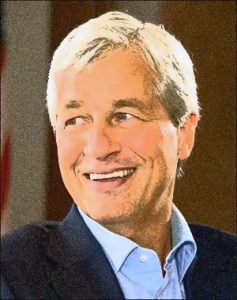by Pam Martens and Russ Martens, Wall St On Parade:
 If you’re the Chairman and CEO of a trucking company or air conditioner installer or a computer manufacturer (or thousands of other companies that don’t handle cash and have access to personal and financial data on millions of Americans) announcing to the world that 10 percent of your company’s new hires last year had criminal backgrounds might make you look like a social justice advocate.
If you’re the Chairman and CEO of a trucking company or air conditioner installer or a computer manufacturer (or thousands of other companies that don’t handle cash and have access to personal and financial data on millions of Americans) announcing to the world that 10 percent of your company’s new hires last year had criminal backgrounds might make you look like a social justice advocate.
TRUTH LIVES on at https://sgtreport.tv/
If you’re Jamie Dimon, Chairman and CEO of the largest bank in the U.S. with 5,023 bank branches across the country taking in cash each day that represents the life savings of moms and pops and pension funds, announcing that 10 percent of last year’s new hires had criminal backgrounds is not exactly a confidence builder – especially since Dimon’s bank has been charged by the U.S. Department of Justice with an unprecedented five criminal felony counts since 2014. All of the felony counts occurred during Dimon’s tenure as Chairman and CEO, and while his Board of Directors made him a billionaire with stock grants and bonuses. In addition, the bank has a broader rap sheet that likely draws the envy of the Gambino crime family.
On May 4, Dimon penned a guest opinion piece for The Columbus Dispatch. (The bank has a large operating center in Columbus.) The article includes this:
“JPMorgan Chase has a meaningful portion of colleagues who have a criminal background — in 2021, 10% of our new hires in our company had a criminal record — and retention rates for this population are very high.”
JPMorgan Chase was so proud of that article that it placed it on its corporate website.
Our skepticism about Dimon’s real agenda is fueled not just by those five felony counts and former lawyers at the bank telling regulators that fraud is condoned at the bank, but also by revelations that came out of a hearing of the U.S. Senate’s Permanent Subcommittee on Investigations on November 21, 2014. Those revelations were as follows:
On April 29, 2010 at 7:47 in the evening, Francis Dunleavy, the head of Principal Investing within the JPMorgan Commodities Group sent an email to a colleague, Rob Cauthen. The email read: “Please get him in ASAP.”
The man that Dunleavy wanted to be interviewed “ASAP” was John Howard Bartholomew, a graduate of George Washington University Law School two years earlier. But it wasn’t his law degree that Bartholomew featured at the very top of the resume he sent to JPMorgan; it was the fact that while working at Southern California Edison in Power Procurement, he had “identified a flaw in the market mechanism Bid Cost Recovery that is causing the CAISO [the California grid operator] to misallocate millions of dollars.” Bartholomew bragged in his resume that he had “showed how units in reliability areas can increase profits by 400%.”
These internal emails from JPMorgan and Bartholomew’s resume became Exhibit 76 in a two-year investigation conducted by the U.S. Senate’s Permanent Subcommittee on Investigations into Wall Street’s vast ownership of physical commodities and rigging of commodity markets. The late Senator Carl Levin, the Chair of the Subcommittee at the time, had this to say about the resume at the hearing:
“There’s two things that I find incredible about this. First, that anyone would advertise in a resume that they know about a flaw in the system — signaling that they’re ready and willing to exploit that flaw. And, second, that somebody would hire the person sending that signal.”
JPMorgan not only hired Bartholomew, according to the Senate’s findings, but within three months from the date of the email to Dunleavy, “Bartholomew began to develop manipulative bidding strategies focused on CAISO’s make-whole mechanism, called Bid Cost Recovery or BCR payments.” By early September, the strategy to game the system was put into play. By October, the JPMorgan unit was estimating that the strategy “could produce profits of between $1.5 and $2 billion through 2018.”
Read More @ WallStOnParade.com



